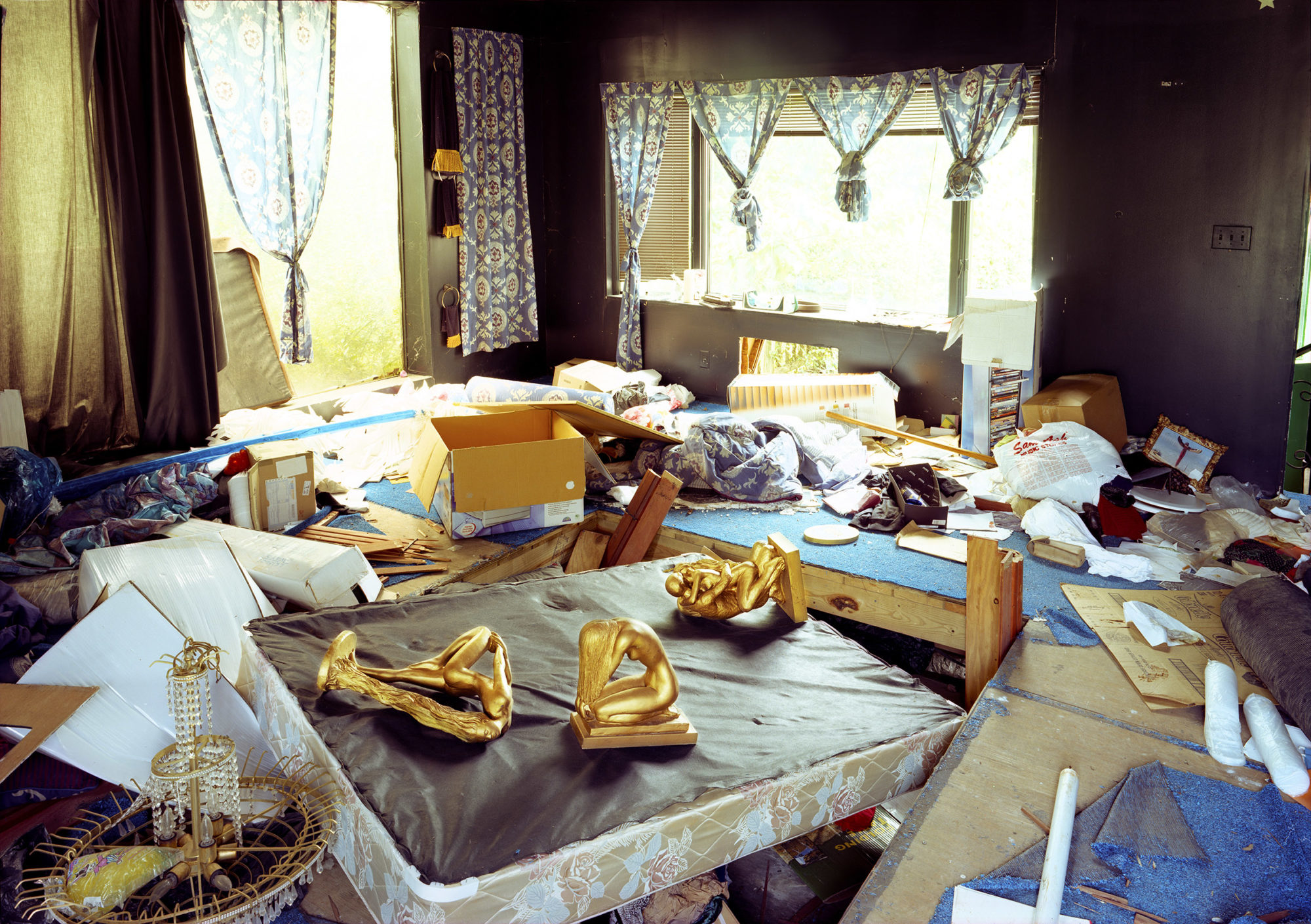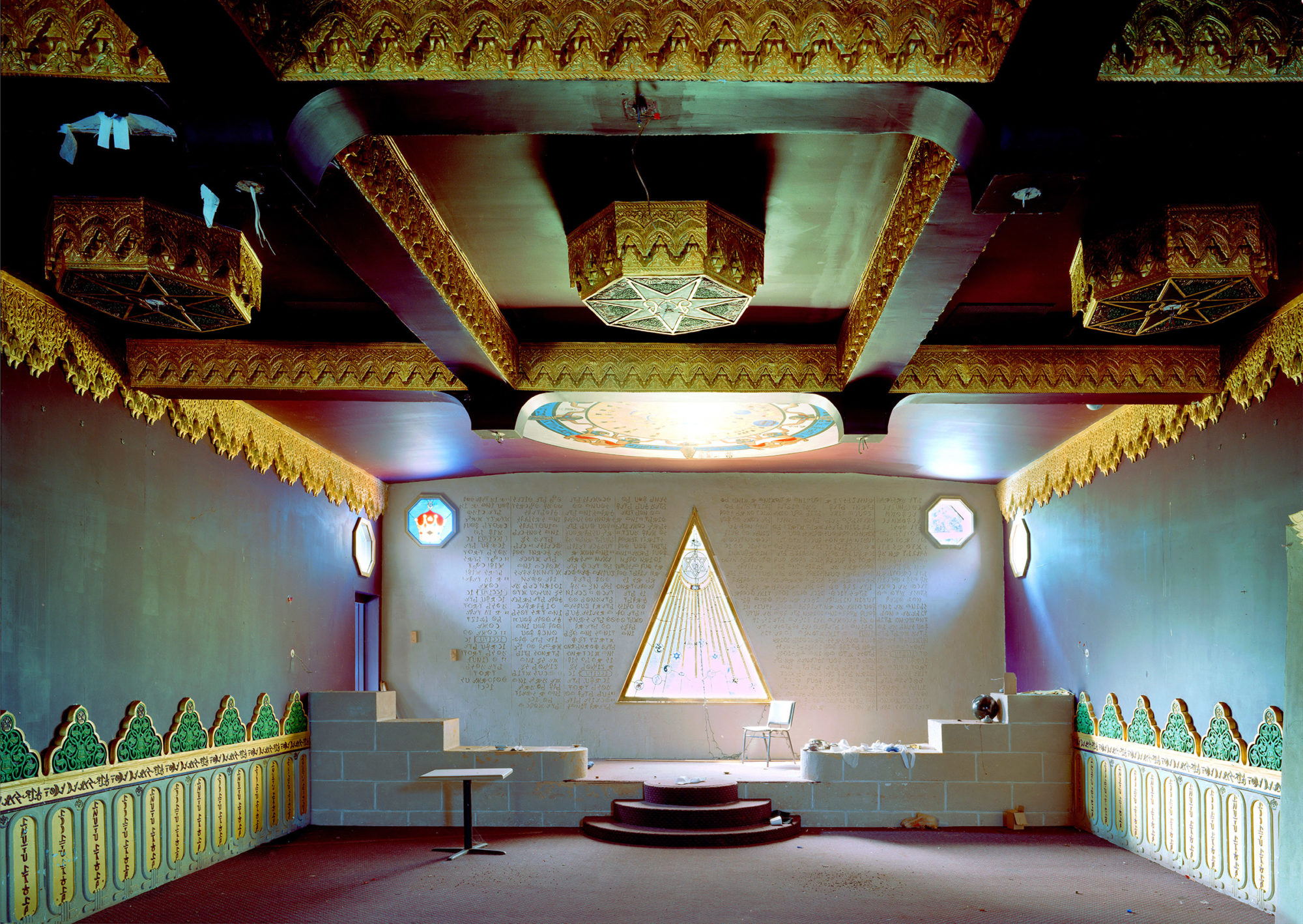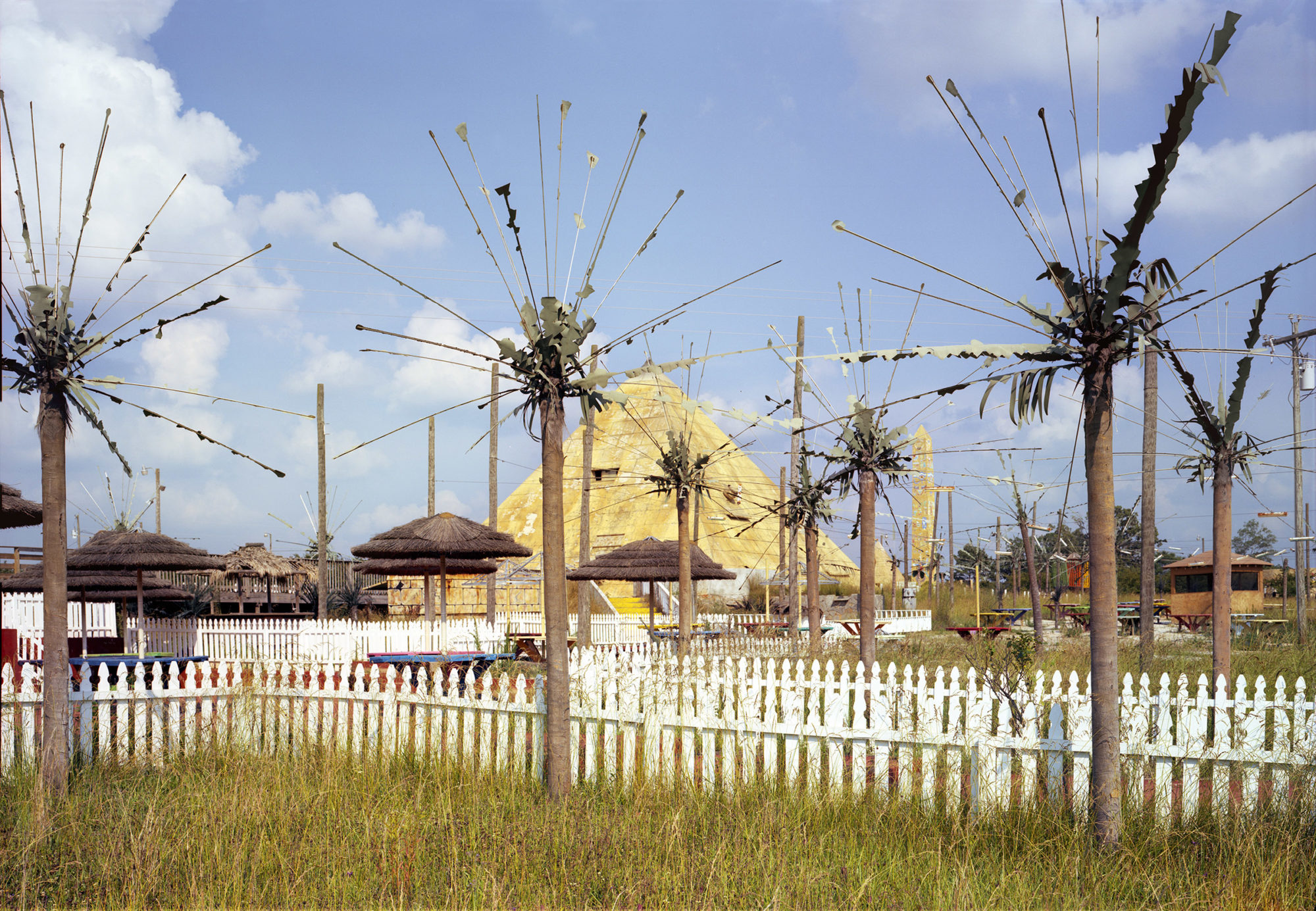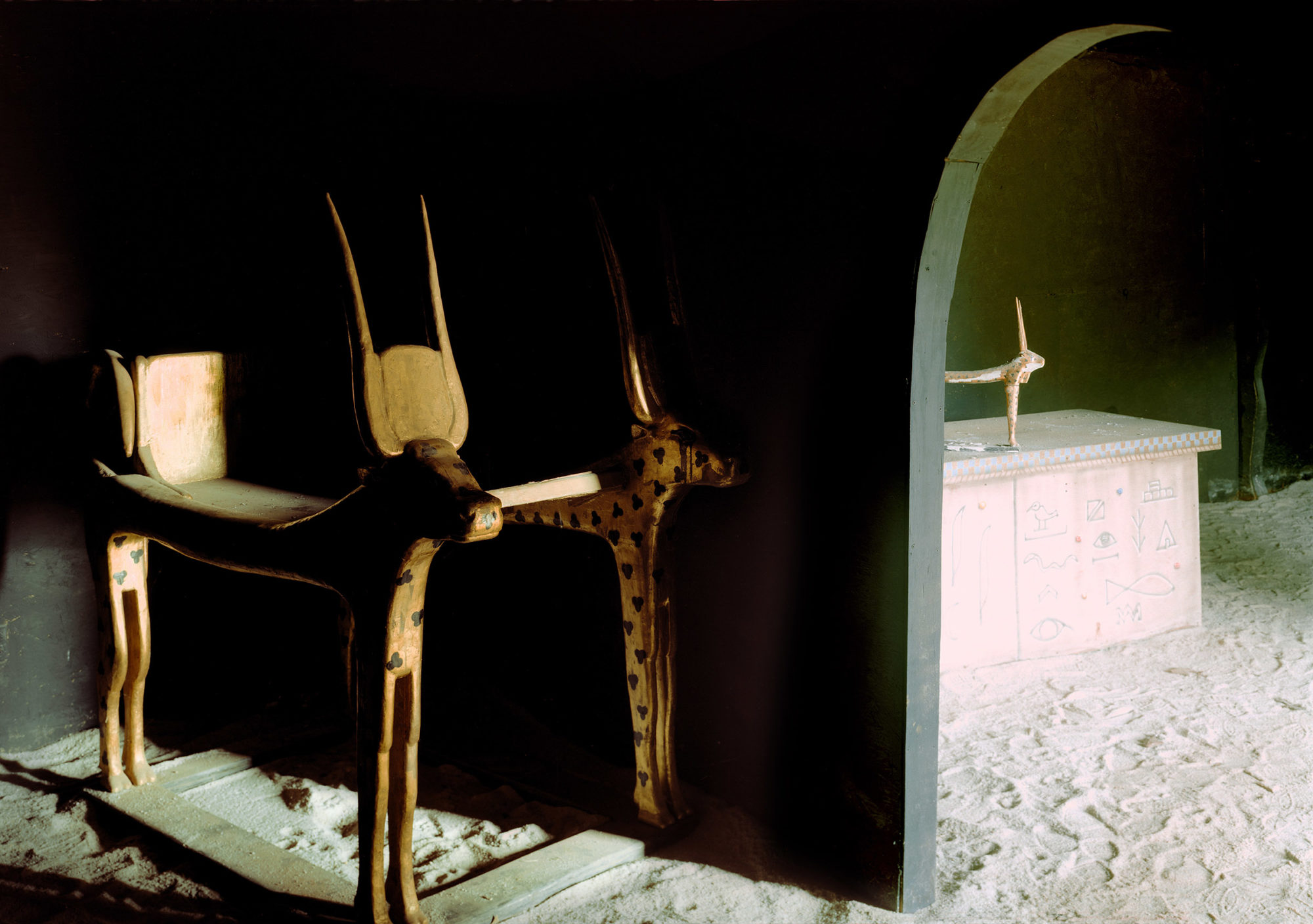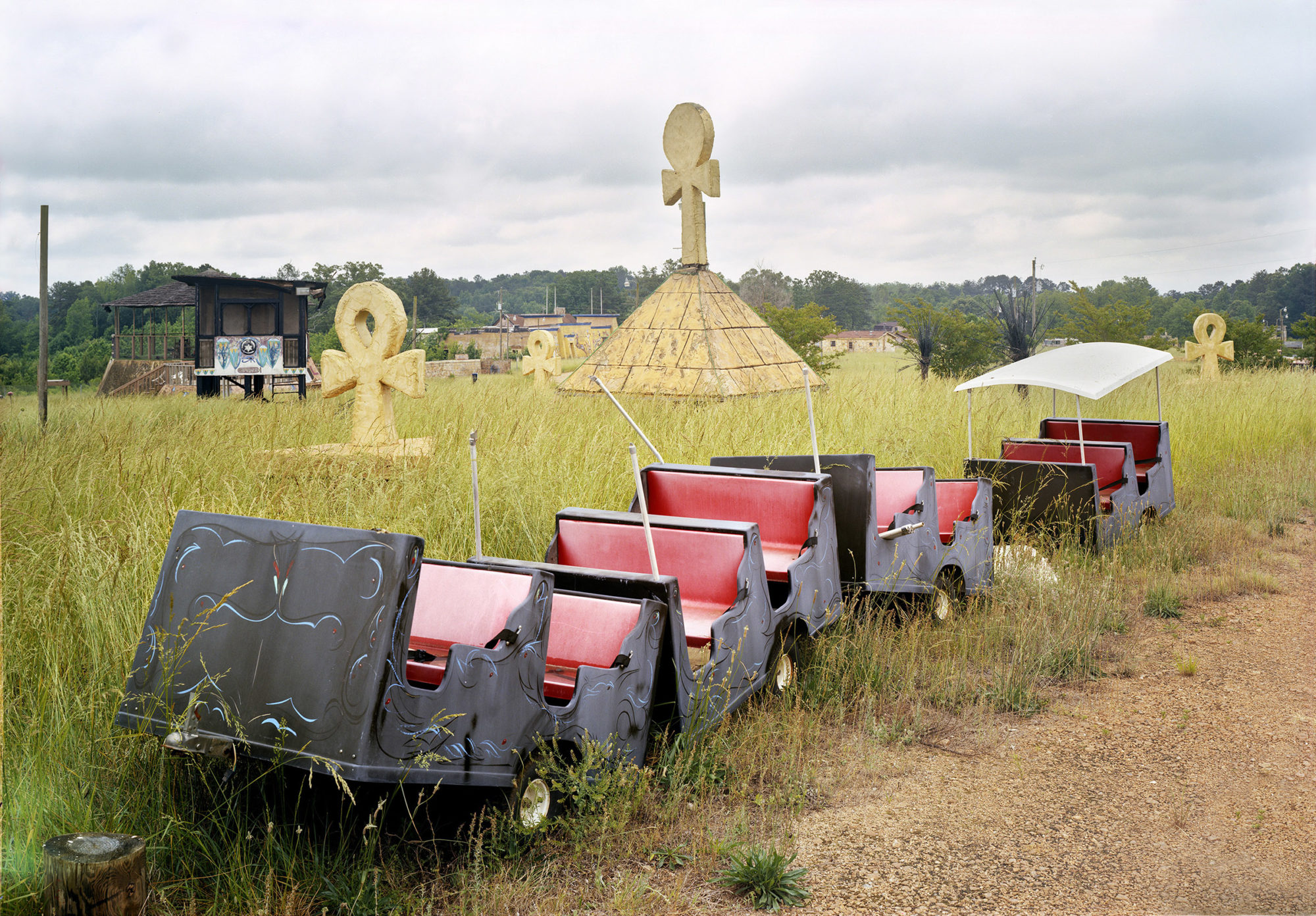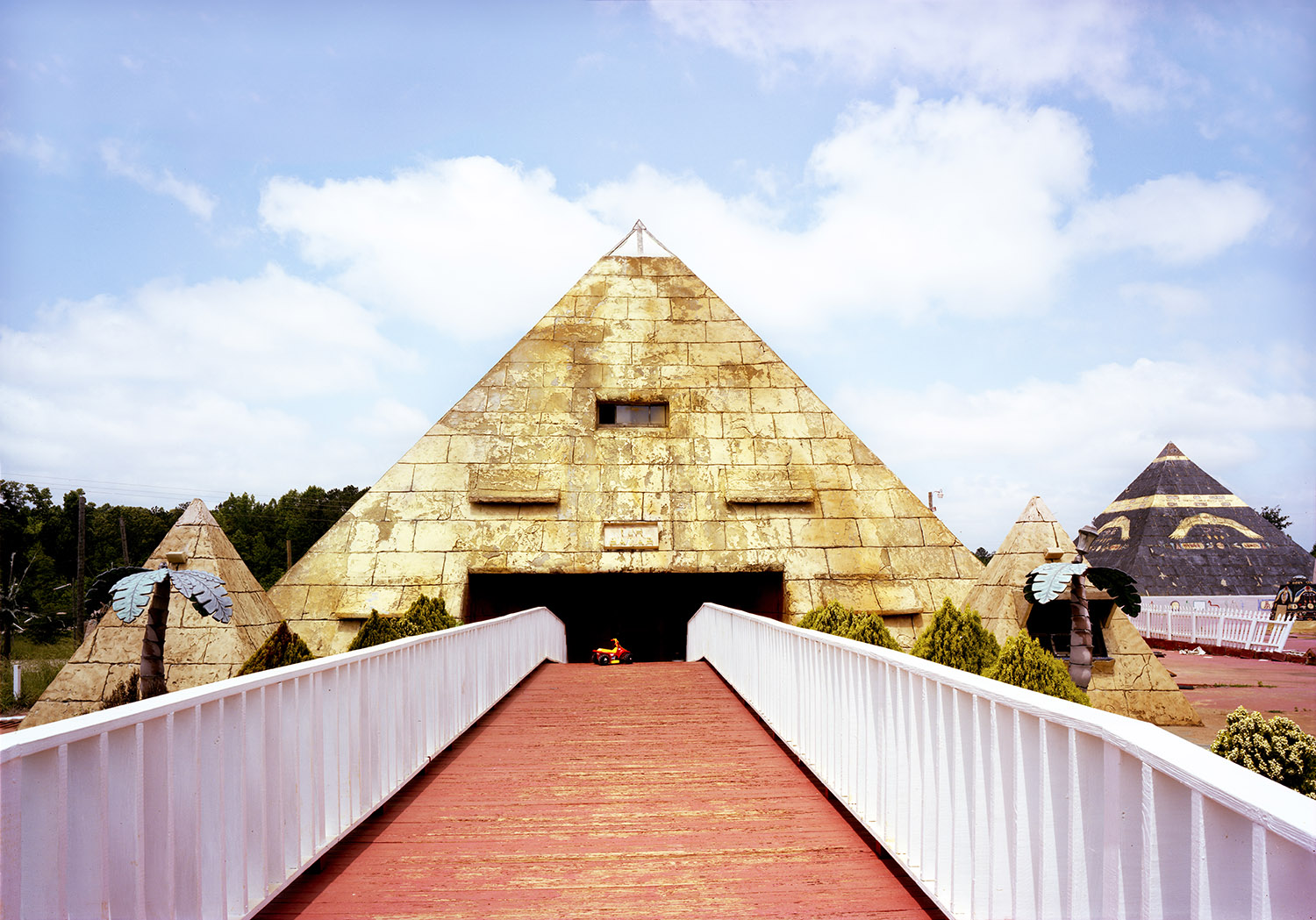Colin Renfrew: Where Are We Going?
Anderson Scott, “Untitled,” 2006 [image courtesy of the artist and Fall Line Press]
Share:
Tama-Re
The photographs presented here are from a published limited edition folio of eight images by Anderson Scott, selected from a larger photographic document that was published by Fall Line Press in early 2016. Both projects are titled Tama-Re and are named for the Putnam County, GA, compound occupied by members of the United Nuwaubian Nation of Moors. The controversial religious group is led by Dwight “Malachi” York, who is currently serving a 135-year prison sentence for charges that includes child molestation and trafficking. After moving to Georgia from Brooklyn in 1993, the Nuwaubians built a neo-ancient Egyptian complex for the devout to inhabit; they did so with what Scott describes as the “color scheme and impermanence of a Mardi Gras float.”
We, as humans, are wrong about most things, especially when it comes to our views of ourselves. As I sat down with Colin Renfrew (Lord Renfrew of Kaimsthorn; former McDonald Institute director and Disney Professor of Archeology at the University of Cambridge; and currently a senior fellow at McDonald Institute) over an afternoon tea of scones and brownies, I asked him to clear up some of the common misconceptions we—in the institutions of the West, especially—seem to perpetuate about ourselves and our cultural origins. These misconceptions stem from a romance with the perceived secrets of the painted caves, a grand mythology of technological progress and acceleration, and an end-of-the-world narrative most recently figured around the crisis of global climate change. As a roadmap, we used Renfrew’s Figuring It Out (2003), a work that poses the following questions: “Where do we come from?” “What are we?” “Where are we going?” These inquiries come from the title of a work by Paul Gauguin, painted in 1897 in Tahiti. Figuring It Out emphasizes that the questions of modern art, and the art that followed it, are also those of modern prehistorians; Renfrew, in seeking to reconstruct human history through the study of ancient civilizations, their commonalities, and their differences, looks for edifying parallels in the art of the last hundred or so years. His work thus intersects that of scholars and critics of contemporary society and culture, and our conversation touched on author and activist Naomi Klein’s vision in This Changes Everything: Capitalism vs. the Climate (2014), and the fracas created by Ai Weiwei with his work Dropping a Han Dynasty Urn (1995), in which the Chinese artist and activist portrays himself doing exactly what its title implies. When distinct spheres intersect in unexpected ways, people say, in English, “It’s a small world”; speaking with Renfrew, I realize the adage summarizes the study of its civilizations, too. The mountain caves of western France are famously home to some of the earliest evidence of “artistic” production—though strictly speaking, we shouldn’t call it that, says Renfrew—and the French have an expression that seems to apply here, too: plus ça change….
Anderson Scott, “Untitled (Malachi York’s bed),” 2006 [image courtesy of the artist and Fall Line Press]
Will Corwin: I recently visited two caves in the Dordogne: Combarelles, a site with engraved images of animals, and Font-de-Gaume, a painted cave, both [executed] approximately 15,000 BCE. Can you shed some light on what you think was going on in these places, and what was going through the minds of these Paleolithic “artists?”
Colin Renfrew: The painted caves are peculiar because they don’t seem to have been visited by many people. You could imagine they’d say, “Great, we’ve got these spaces underground, we can paint up a space, we can have a great community here, we can have communal rituals,” but many of the painted caves are in very remote places; they’re not places where you’d want to encourage people in any numbers to come together. The mud of the cave floor in some cases indicates they really were not much visited. So, getting a grip on what cave art was for is quite difficult. It’s much easier to empathize with the people who wanted a great get-together—and like most places for get-togethers, there were probably other things going on. If you think about some of the great Greek sanctuaries like Olympia or Delphi, that’s where communal games started: the Olympic games, the Pythian games, and so on. It’s more difficult to empathize with people going down long passageways underground, with only very poor lighting, and doing paintings that hardly anybody else ever saw until archeologists began to get interested in them, thousands of years later.
WC: Can you hazard a guess as to why they did them in these obscure places?
CR: Well, there’s quite a range of theories, some of them involving altered states of consciousness, which I don’t particularly see the force of. The best theory that I’ve heard is that they were used for educational purposes—prehistoric education, when you have just a few adolescents, initiates, who are going to be taught about hunting, maybe a lot of other things. A lot of hunter-gatherer communities have rites of initiation when people reach adulthood, which involve imparting historic lore. This is really what the educational structure is for hunter-gatherer communities: it’s passing on wisdom, experience, and knowledge, and the paintings may have been part of that process. They may have been going down there to have some great emotional shock, and to be told some important truths that would be of use to them and that they would impart to the next generation—secret medical lore, how to hunt successfully, how to gather crops, what crops are poisonous.
WC: In your book “Prehistory: The Making of the Human Mind” (2008) you discuss the fact for most that for most of our existence as a species, we have lived [almost without] any perceivable material culture. This is a disturbing revelation in terms of our perception of ourselves as creative beings.
CR: Homo Sapiens evolved something like 200,000 years ago in Africa; it seems that our species was well-shaped at least 100,000 years ago, so that a child born then would be pretty much the same genetically as a child born yesterday. We know that farming began around ten or twelve thousand years ago, so it was still the life of a hunter-gatherer in the later Stone Age until farming began—a time-span of say 40,000–50,000 years. So, the Sapient Paradox is that if these clever communities of Homo Sapiens existed in Africa 60,000 years ago, why did human society take so long to get its act together and create cities and civilization? Why in recent years have we been on such an accelerated pattern of change?
Anderson Scott, “Untitled (Assembly Room),” 2006 [image courtesy of the artist and Fall Line Press]
WC: What artifacts are there from the ancestors that are from that 60,000 year period of the Sapient Paradox that give any indication of cultural practices? Can you say with confidence that they were “creative”?
CR: You can say that. It was around 60,000 or 70,000 years ago that you find the first personal adornments—shell beads for instance—and although that may not sound like very much, that’s the first time that you can see Homo Sapiens putting these things round their necks and being admired for them. So, since that time, it’s been a nice thing to look good—and they took some trouble to look good. That’s a very important moment in humankind actually, in self-awareness. That’s the first evidence we see of a developing aesthetic sense, unless of course you look at those wonderful hand axes, of a much earlier date, or those beautifully symmetrical flint tools. It’s easy to begin to get excited about them as beautifully made, so that’s another kind of aesthetic, isn’t it?
WC: When could you begin to detect an aesthetic or creative impulse that goes beyond embellishing these accessories? Where does storage become a sanctuary, for instance?
CR: In the Orkney Islands, where Quanterness is located, the preservation is very good: there are still wonderful circles of standing stones, which were erected nearly 5,000 years ago. Quanterness is a burial monument—a so-called chamber tomb. But if you’re going to get rid of bodies and bones, you don’t have to make a great tomb or a beautifully fashioned building. They didn’t live in buildings as impressive as this, so you can intuit or infer some of their intentionality—they set out to make a well-built and imposing monument or circle of standing stones. Nothing tells us now how much it meant to them except for the fact that they invested so much energy, enough for it to survive for nearly 5,000 years, and in rather good condition. It was something that was intended to survive—perhaps for eternity. We don’t know what their ideas about eternity were, but perhaps they weren’t so very different from ours.
WC: You’ve drawn parallels between these monuments and some contemporary art—you’ve compared Quanterness to the work of Richard Long, for instance, a British land artist.
CR: Well, they can look quite similar! It was a superficial similarity that took my attention with Richard Long. We’d opened up a rectangular area down the side of Quanterness, which we came upon as a grass-covered mound, and went down to the stone work. When we’d very carefully taken off the stone work, it looked rather like something by Long. Just a couple of years later he [did] Chalk Line (1984) at the University of Southampton, where he brought in a lot of chalk and very carefully arranged a rectangular-shaped line of stones. The work is imposing and arresting, and it’s very impressive that it’s the work of one person. It makes a statement, and that’s where it compares with the prehistoric work. You’ve got a circle—I’m thinking of the Ring of Brodgar in the Orkney Islands, which is not quite as complicated as Stonehenge—but what’s it for? There are many answers to that question, and it’s perhaps not well-answered by any of them, but one thing you can say is that they were making a statement. That’s one of the aspects of the work of Richard Long: he’s just modified something in the countryside—rearranged some stones into a line, or made circles of snow in the mountains—but it is striking, and a little unnerving sometimes. That’s the community of feeling that I felt between this work and these prehistoric monuments. Whoever made a prehistoric monument may well have had a lot of philosophical baggage, but we don’t hear their literal voices, so we don’t know what they meant precisely. We just know they were making a powerful statement and that it still exists.
Anderson Scott, “Untitled (Picnic area and golden pyramid),” 2006 [image courtesy of the artist and Fall Line Press]
WC: Comparing something like the efforts at Quanterness to those of contemporary art, on one hand there seems to be a community working together to produce something, and on the other, an individual. Can we consider these communal projects “sculpture”—artistic or existential statements as well as functional buildings?
CR: If you think of just about any building in the modern world, as in the ancient world, it is the work of many hands, though no doubt there is one person, or maybe a few people who’ve really thought out what they are going to do, who we would now call the “architect” of a lot of people bringing that into reality. The modern builder is doing much the same thing as the ancient builder. Of course, you can’t transfer a contemporary artist back into early times, because we live in a society that has identified “art.” You do see interest in the work of the individual artist, the “named” artist, emerging in classical Greece. After that it fades out, but then reappears in the Middle Ages, and gets very high-powered in the Renaissance, where for the first time a great artist like Michelangelo or Raphael kept company with princes, and had a much higher social status than artists did in Greek times.
WC: You discuss text-based work in “Figuring It Out” (2003), in which you explore the common ground of archaeology and contemporary art. You characterize the advent of text as the end of prehistory, yet some contemporary artists seem to use language almost in an archaic way—visually, or as a basic proxy or label. How do you relate text-based artwork—such as Jenny Holzer’s or Ian Hamilton Finlay’s—to original uses of inscription?
CR: Our species has probably used spoken words since the beginning, or indeed earlier. It’s a big argument, whether earlier hominids like Homo Erectus were speaking or not—we still don’t understand all that we soon will understand, no doubt, about what genetic makeup is necessary for humans to be able to speak the kind of language we speak, with grammar, past and future tenses, and so on. It is clearly a feature that all human societies have today, and societies have probably all had it, going back 70,000 years: as humans, we all use words in a sophisticated way. But it was something completely new when writing began: you could represent words visually. It is fascinating that some contemporary artists, like Holzer, make very short, sometimes arresting statements, which may go up in lights in Piccadilly Circus or in Times Square: “Money Creates Taste.” Ian Hamilton Finley also makes very concise statements in writing and carves them on stone; most of his statements are monumental: they could be epitaphs, they’re aphorisms made to last.
WC: So, writing is not just a development that made for ease of record-keeping—how many bales for grain are stored for winter—but it’s tied to humans’ ability and inclination to make monuments, designed in some regard to stand the test of time?
CR: Writing came into existence in a number of different places at different times. In Mesopotamia, one of the sources of writing was just to make for ease and permanency in accounting, so many of the inscriptions are on clay tablets no more interesting than bus tickets. But around that time you also have inscriptions that have a monumental significance. In Minoan Crete, there are objects of stone that have inscriptions with religious significance. You have sculptures of deities on which the deity is named. So writing often originated in the context of trade and exchange, yet at the same time, there’s the undertone that writing can be used in a way that is permanent: you can use it to make an inscription that is intended to last.
It’s interesting that the earliest immortal deities, gods and goddesses, seem to emerge at the same time that state societies emerged—hierarchical, stratified societies with upper-class people and lower-class people—and that the emergence of writing happens at about the same time that you have the chance of knowing the name of the deity. There are images one could think of as religious images going back several thousand years earlier, but it gets very difficult when you go back to the time of the cave paintings we’re speaking of, to Paleolithic times. You do find small human forms, mainly female forms, so-called Venus figurines. But that’s modern terminology—they’re called Venus just because they represent women; there may be some fertility context there, but it’s impossible to really know that they’re images of goddesses. How would you show that? Once you can actually see immortal deities before your eyes in sculpture, and have them named in writing—that is when state societies begin to emerge.
Anderson Scott, “Untitled (Golden cattle in the mail temple building),” 2006 [image courtesy of the artist and Fall Line Press]
WC: So, there is a synchronicity—a cause/effect relationship, even—between writing and monuments, and the rise of structures such as that of capitalist society? You discuss capitalism in “This Changes Everything”—what is its purpose, in terms of evolution, for the human species?
CR: Well, things in evolution come about because they’re effective, because they work—that’s what the survival of the fittest is about. The ones that survive are the ones that work, and clearly capitalism has been a means of surviving so far, although some authors, such as Naomi Klein, have their doubts about how long it may last. One of the problems is the rush to growth on a scale we can’t maintain, which is a disquieting feature of most economies today. At the moment—and nobody’s saying we should stop having growth—that is thought of as suicidal. Yet it’s difficult to see how the world can be stabilized unless we stop.
WC: Klein has argued that because of the effects of this growth, namely climate change, we’re now more vulnerable to the environment. This sounds like a return to where we were 15,000–30,000 years ago, when the natural environment posed a fundamental threat to the human populace.
CR: There are all kinds of strains in the modern political economy, even before you talk about climate change, which are [products] of growth. There are very few political economists who are advocating an end to growth, though that would be the simplest solution to our present problems. We have always been at the mercy of the environment. During the time of the great ice sheets, the sea levels were lower than they are today by tens, even hundreds of feet. We are rightly sensitive because for some Pacific islands, if the world sea levels go up by even two or more feet there will be widespread inundation, but two or three feet in terms of global history is not a very big change in sea level. Basically, people have had to get out of the way.
WC: You have written about Indus River Valley culture as a prehistoric example of a nonhierarchical alternative to capitalism—do we have enough archaeological evidence to take cues from these societies?
CR: Indus Valley culture is interesting because it had great cities, some of which have been excavated, yet it doesn’t seem to have had the same kind of rulership system that we’re familiar with in Egypt or Mesopotamia, where there were very conspicuous and wealthy rulers. Unfortunately, what little writing was found in the Indus Valley has not been deciphered, so we learn nothing at all from the written records of the period. It was clearly well organized, so there must have been a system of discipline. It’s possible it might have been more volunteeristic, if you like that word—people could participate—though it’s not entirely clear that was so. Maybe it was just as despotic as some other Oriental societies were, and we just don’t see the way that the despotism manifested itself as clearly. Yet it is one of the most interesting societies of the prehistoric world because it was a great civilization with great cities and yet lacks that clear social hierarchy, and indeed [one] lacking a clear hierarchy of deities.
Anderson Scott, “Untitled (Site-seeing train),” 2006 [image courtesy of the artist and Fall Line Press]
WC: In state or capitalist societies, the dwellings of the wealthy are built to last; those of the poor typically are not. Couldn’t we just be looking at the remains of better housing, for richer people?
CR: In many ancient societies you find exactly that: palaces. In Egypt you find the wonderful facilities for the pharaoh, who uses beautiful artifacts and has access to all kinds of wealth. You find the kind of society we are familiar with from the Roman period or from the Middle Ages, of rulers with great wealth and lower classes with great poverty. Yet in the Indus Valley you don’t see this conspicuous wealth. You do see large numbers of people living in a great urban complex, without very much visual decoration, without very much iconography—so we don’t have the narrative features of their lives.
WC: It speaks to the idea that human beings themselves are not necessarily inherently hierarchical.
CR: I think there’s a very simple, very reasonable argument that when human societies grow beyond a certain number, there’s a use for hierarchy, because you need some social structure. It doesn’t always have to be rich and poor, but in any modern society, any urban society, even if we’re talking for instance about a theoretical communist society, you still have administrative hierarchies; you still have to have a military hierarchy. You can’t run an army without having generals.
WC: On the subject of the ancient artifacts of wealth and hierarchy, did you consider including Ai Weiwei in the artists you talk about in Figuring It Out? What are your thoughts on his piece, Dropping a Han Dynasty Urn, in which the artist does precisely what the title implies?
CR: Ai Weiwei is one of those artists who manages, with a gesture, to make a very clear statement. It is really a sacrilegious act deliberately to break a [Han] vase, so it makes a wonderful work of art to deliberately undertake a sacrilegious act and record it visually in an effective form. As an archeologist, I think we should show respect towards the relics of the past, and like many other people I disapprove of the destruction of [Han] Vases. Here, though, it is probably the case that you can’t make an omelet without breaking eggs. Ai Weiwei is not setting out to destroy all the images of the Lord Buddha that exist, he’s simply taking one very precious object, and undertaking a symbolic gesture. I think I can live with it.
Anderson Scott, “Untitled (Big wheel in front of golden pyramid),” 2006 [image courtesy of the artist and Fall Line Press]
WC: And on the subject of violence combined with artistic expression, in the course of your excavations, have you come across any evidence of human sacrifice?
CR: I have never personally encountered indications of it, but one friend of mine has. He is a Minoan specialist, and I think he was rather troubled since he felt it somehow reflected badly on the Minoans. I do remember finding it rather moving when I was excavating a series of medieval skeletons in what had been a churchyard, as a student. To be uncovering the complete and articulated skeleton of another human being is, at least for the first few times, a thought-provoking experience. I sat down and reread Thomas Gray’s “Elegy Written in a Country Churchyard.”
WC: My line of questioning arises from passages in Prehistory, in which you describe the discovery of a sacrificial victim, along with several sacrificed animals, as part of the construction process of a structure in Teotihuacan, and in the royal tombs at Ur. Clearly the practice of bloodletting and sacrifice have been part of artistic and architectural practices throughout the world and over much of human history, and continue to exist in metaphorical form, but the contemporary human being tends to view the practice mostly from a perspective of horror. Is it ever possible to contextualize this practice historically?
CR: Is human sacrifice so very far removed from legally sanctified execution? I read today that in Utah you American citizens now have execution rifle squads, because some manufacturers of potentially lethal drugs do not like to export them to the USA for the purposes of capital punishment. Is the organized ending of human life by persons of “good will” so very different in the one case than in the other? In a world when we can still contemplate thousands of civilian casualties, at Dresden or Hiroshima, surely we are already in face of human sacrifice on a large scale. Dulce et decorum est pro patria mori [how sweet and glorious to die for one’s country]. Of course, it may be different in those cases where the human sacrifice is calmly and carefully planned. In some cases, for instance among the Aztecs, these were enemies captured in battle. In other cases they may have been individuals who went to their deaths willingly enough—as indeed do many of those who have [at various stages in religious history] been regarded as martyrs. And remember that quite a few rational people contemplate suicide with equanimity: the great archaeologist Gordon Childe was one of these. So I think that we may perhaps exaggerate the “foreignness” of human sacrifice. It is not more foreign than capital punishment, and much less foreign than the fate of countless socially stigmatized persons throughout history.
WC: I’ll finish by channeling my inner Werner Herzog: in your moments of daydreaming, letting go of the precise drawings of the strata and the careful mapping that goes along with excavation, in your heart, why do you think those artists painted those lions in … Chauvet [Cave] or the bison in Font-de-Gaume, or carved the mammoths and horses into the walls of Combarelles?
CR: The contemporary artist is thinking of art as an existential experience and a commentary on human existence. I think it likely that those prehistoric artists in the caves of France and Spain were doing what they were doing for a much more specific purpose. They went to a lot of trouble to do these things: there must have been rewards in doing them, though I don’t imagine they were the rewards that the contemporary artist may feel. I doubt [that] they were setting out to express their deepest feelings. But the wonderful thing is that whether or not that was their primary purpose, they succeeded in making works which evoke, by way of commentary, very deep feelings in us.
Will Corwin is a sculptor from New York. His work has been exhibited at the Clocktower Gallery and LaMama Gallery in New York, George and Jørgen Gallery in London, and Frise Kunstlerhaus in Hamburg. He writes for ART PAPERS, Frieze, The Brooklyn Rail, and BOMB, and he has a regular show on Clocktower Radio. This fall he is curating the exhibitions Cyborg at Zürcher Studio and Devotion at the Catinca Tabacaru Gallery, both in New York.
We would like to thank Anna Preston Gelderd, Dillon Cohen, Katie Holten, Gérard and France Polese, and David Hirsh for their assistance with this project.
This interview originally appeared in ART PAPERS November/December 2015.
